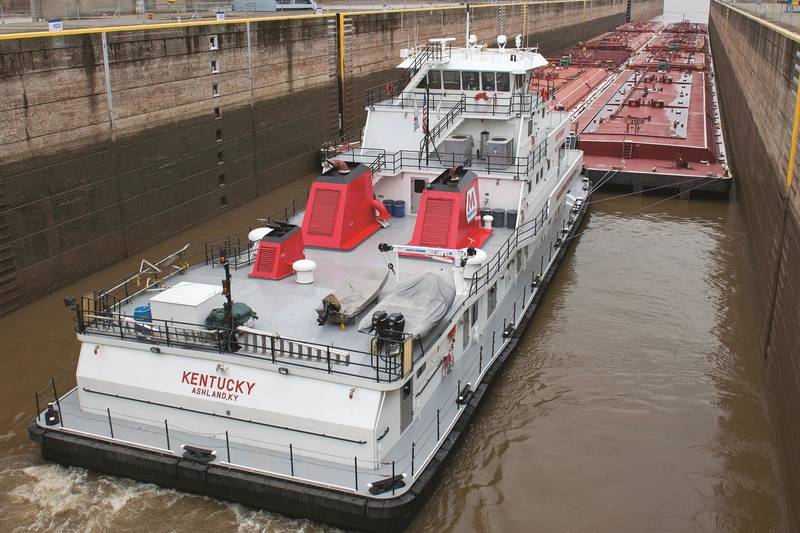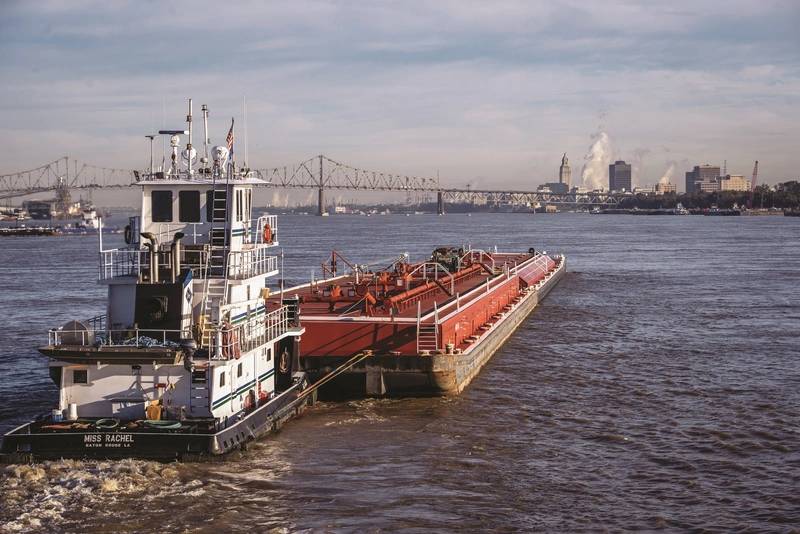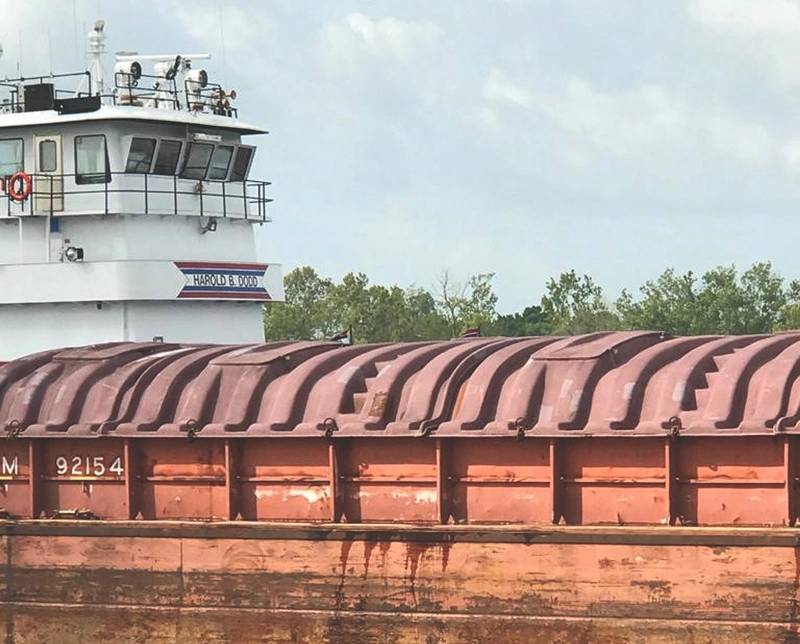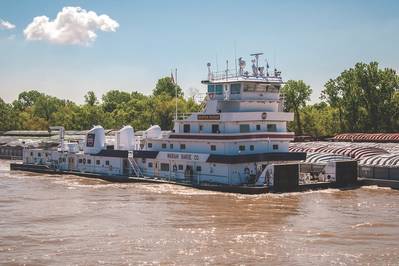US Inland Waterways: High Waters & Swirling Currents
The inland waterway system, flowing through the United States heartland, is a microcosm of all that has been happening in 2020: trade tensions, infrastructure issues, shifting trends in fuel consumption and the pandemic that has gripped us since the winter months. Shortly after the initial coronavirus outbreak here in the U.S., maritime workers were deemed to be “essential”, paving the way for cargo flows to recover from their springtime nadir. As COVID-19 infections turned up on U.S. shores, the boats continued plying the waterways, albeit with reduced volumes in some cases. Notably, the American Waterway Operators (AWO) took a proactive role in guiding its members on best safety practices. At a time that supply chains are ripe for fine-tuning, participants are not standing idly by, waiting for demand to bounce back; rather, they are exploring new business alliances, and picking up on another trend, digitalization.
The macro picture shows that cargo flows on the inland river system peaked in 2004-2006, reaching approximately 625 million short tons in those years (440 million dry and 185 million tank basis 2006). By 2017, overall tonnage stood just over 530 million short tons. Coal movements on the inland system have seen sharp declines; in the late 1990s, 176 million tons of coal moved annually (out of 600 million total inland tons). By 2016, 110 million tons of coal were moving on the system (the majority originating in the Ohio River region), with the decline of coal fired powerplants (though export traffic has been an incremental positive in strong years such as 2017 and 2018).
Agricultural cargo flows are heavily linked to exports. Corn and soybean exports (which create demand for downbound cargo on the river system) generally were lackluster throughout much of calendar 2020, though observers pointed to a strengthening late in the year. The trade war attracts headlines; an announced U.S. review of the Trade Deal agreed with China in January, 2020 has been delayed. In mid-September, an officer of the U.S. Grains Council (representing U.S. agricultural producers), speaking about China, said, “Importers are expanding their trading capabilities in the United States and partnering with key river freight and port loading facilities. These are signs China will continue to procure grain from the United States well beyond recent purchases.” In an early October 2020 report, the U.S. Department of Agriculture said, “…if the early projections [based on current trends] are realized, the higher exports would significantly increase the demand for transportation.”
Meanwhile, infrastructure issues continue to loom large. Looking toward Washington, D.C. the House quickly passed the Water Resources Development Act (WRDA) in mid-year, but, several weeks prior to the 2020 elections, had not yet cleared the Senate. Cost sharing on inland projects (presently a 50%/50% split between the U.S. Treasury and Inland Waterways Trust Fund, or IWTF) is one item still to be worked out. The bill would modify the inland waterways project cost-share to 65% U.S. Treasury and 35% from the IWTF, which funded by a tax from commercial barge fuel on federally maintained waterways.
 (Photo: Marathon Petroleum)
(Photo: Marathon Petroleum)
Earlier this year, the reduced cargo flows took a major casualty, as inland stalwart American Commercial Lines (ACL)—reportedly controlling more than 20% of covered hopper capacity (approximately 3,000 barges)—filed for a bankruptcy reorganization in early February. Three months later, a recapitalized ACL emerged from a prepackaged bankruptcy, with debt reduced by approximately $1 billion. The previous debt holders, linked to a $640 million credit facility led by Wells Fargo Capital Finance and a $1.5 billion revolving credit led by Bank of America, emerged with 95% ownership in the newly capitalized company. Bankruptcy case filings reveal the deleterious financial straits just prior to the filing: “As of December 31, 2019, ACL generated approximately $974 million in operating revenues for the prior 12-month period and incurred a net loss of approximately $140 million. Its unaudited balance sheet reflected assets of approximately $1.441 billion and liabilities of approximately $1.977 billion as of December 31, 2019.”
Ingram Barge, with a home base in Nashville, is a leader in the dry segment. operating nearly 4,500 barges (mainly dry) with a fleet of more than 150 tug/tow boats. The total dry barge fleet totals approximately 18,600 units. Other large owners include American River Transport (ARTCO, controlling roughly 1800 covered barges), Marquette Transportation, based in Paducah, Ky., with 800 barges and Campbell Transportation, headquartered near the Monongahela River, with more than 700 barges.
Liquid cargo is also a big mover on the waterways, with NYSE-listed Kirby Corporation providing visibility into a business dominated by private entities. Consolidation, in the form of corporate acquisitions by well-resourced participants, has continued. In early 2020, Kirby acquired the inland barges (92 units aggregating 2.5 million bbl of capacity ) and fleet of 45 boats of Savage Marine (along with a bunkering business) for $279 million. This follows up on blockbuster asset acquisitions of 2018 Higman Marine (163 barges) and 2019 Cenac Marine (63 barges). At mid-year, Kirby controlled 324 river towboats and 1,131 inland barges. The league tables in the tank barge sector include ACL with 408 tank barges at mid-2020, Canal Barge with 340, Ingram with 276 and Florida Marine Transporters with 270 barges.
 (Photo: Kirby Corp)
(Photo: Kirby Corp)
Randy Giveans, Jefferies & Company equities analyst, writing at the time of a recent Kirby earnings release, linked the inland tank barge business to developments in the petroleum and chemicals businesses. Writing about the overall sector, he explained, “The current economic crisis has put downward pressure on both refinery and petchem utilization, leading to reductions in both volumes and rates for the inland barge market.”
Giveans continued, “Utilization had begun to rise, but was battered again by recent hurricanes and storms in the US Gulf while refiners continued to struggle due to reduced demand for fuels. Inland utilization remains below 80%, resulting in both spot and term pricing down roughly 5-10%.”
A top executive from Golding Barge Line (with two dozen boats and 65 barges), headquartered on the Lower Mississippi and active in the refined products and chemical trades, interviewed in an early September on a public radio program, cast a very cautious tone. He commented, “This has been the roughest disruption that we’ve dealt with is in our company’s history. And we were definitely feeling it on our end from a volume standpoint… People are just not moving product like they did before.” Kirby Corporation, in a late September regulatory filing, said, “Reduced demand as a result of the COVID-19 pandemic and resulting economic slowdown contributed to lower utilization during the 2020 second quarter.”
Going forward, the medicine for the sector’s health will come from broader economic trends. Giveans, from Jefferies, wrote, “[Kirby] continues to be the strongest player in its respective markets and has a fortress balance sheet to weather both the literal and figurative storms as the global economy continues to show signs of economic recovery.” He pointed out that, “On a positive note, newbuilding ordering remains weak, with very few net additions expected this year. Looking ahead, increased refinery utilization should boost inland barge volumes and pricing.”
Kirby’s filing, in its forward outlook, offered that “with barge utilization rates starting the 2020 third quarter in the mid-70% range, the company anticipates lower average barge utilization sequentially.” The barge supply is the other side of the equation, with Kirby saying, “Given current market conditions as a result of the COVID-19 pandemic, the company believes that industry retirements could be in the higher end of the historical range during 2020,” citing potential retirements of 500 barges (out of an industry fleet of 4,000 tank barges) during 2020 (compared to a “normal” retirement count of 75-150 barges).
 (Photo: Barry Parker)
(Photo: Barry Parker)
For bulk cargo, barge transportation offers great economies compared to surface transport but does not always offer a close connection with cargo originators. In recent years, the Inland River Services group within NYSE-listed Seacor Holdings Inc., which manages more than 1,110 barges (including the former Bunge grain fleet and those of leasing giant SCF), has augmented its primary dry bulk business with a niche hauling containers between Memphis and New Orleans, with empties downbound and laden boxes moving into the Port of New Orleans sent up the river to major distribution hubs Memphis and St. Louis.
Success in the business has required deep logistics expertise that could be ported from adjacent sectors, and, increasingly, strategies for meeting sustainability objectives. A potential new entrant to the river marketplace, American Patriot Holdings, has big plans, with a design for a liquefied natural gas (LNG) fueled vessel that could haul 2,400 trailers in the inland trades. If plans go forward, the innovative vessel (with the owners discussing up to four newbuilds) would figure into plans for future intermodal terminals to be constructed at Plaquemines Parish, in Louisiana, and Cairo, Ill.
Like other maritime sectors, the inland business is driven by external trends. Digitalization, a trend across all businesses, is taking place on the customer side, and carriers will need to integrate with the cargo side’s information infrastructure. When it comes to linking customers’ supply chains digitally, dry barge stalwart Ingram has been innovative with its Towline, while others, including ARTCO with its e-ARTCO, ACBL with its ACBL_Trac, Kirby and Marquette have all made strides in this area. Necessity has been the mother of invention in 2020, a time when the industry is halfway into its Subchapter M inspection program. Equipment owners have now seen virtual inspections, by both the U.S. Coast Guard and by inspectors from Third Party Organizations (TPOs), against the backdrop of restricted travel.
Shipper-owned equipment still plays a role in supply chains. On the dry side, ARTCO is tied to grain giant Archer Daniels Midland (ADM). In the liquid sector, midstreamers MPLX (a partnership owning 300 barges, linked to Marathon Petroleum) and Enterprise Product Partners have integrated their barge fleets into broader supply operations, while privately held Magnolia Marine Transport (with nearly 100 tank barges, mainly in the dirty oil and asphalt trades) is tied to the closely held refiner and marketer Ergon.
“ESG” (Environment, Social, Governance) is also finding its way into the business, albeit more likely to impact listed companies. SCF, the barge owning arm of Seacor, recently touted its purchases of carbon credits as a way to offer its container on barge customers a much-desired carbon neutral transport alternative. In 2020, Kirby Corp provided a lengthy “Sustainability Report” that included some old themes (safety, no spills, good citizenship) but also broke new ground providing some real numbers on CO2 emissions for the barge fleet overall, and for Kirby specifically now, and for enhancements to future reports. The “E” trend shows no signs of abating. Domestic boat owners ought to be looking carefully at the international deepsea shipping sector, where a group of major dry bulk cargo providers (including ADM, Bunge, Cargill and Louis Dreyfus, all well-known in the inland markets) have agreed, in early October, to measure, and publicly disclose, the CO2 emissions from their shipping activities.















